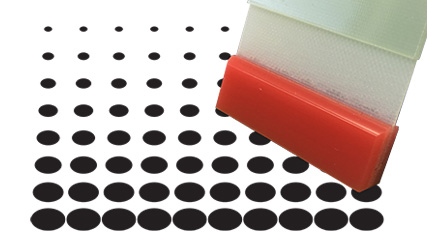“High Precision Screen Printing with Low Printing Pressure!”
Since our establishment, Micro-Tech Co., Ltd. has always touted this as a feature of our in-house facilities.
Regardless! Regardless! “Low Printing Pressure! High Precision!” We passionately appeal to this at trade shows, customer visits, and during test printing.
“But what does low printing pressure mean for high precision?”
We often receive such inquiries from customers, prompting us to create this article to provide a clearer explanation.
The theme is “What is low printing pressure?”
To ensure easy reading during spare moments, we’ll deliver this in short installments!
We’ll update at a relaxed pace, and we kindly ask for your understanding.
What is “Printing Pressure”?
Screen printing, as the name suggests, is one of the processes in the printing process.
As mentioned in this article:
Screen printing involves:
- Coating the screen with paste using a scraper,
- Skewing while applying downward pressure with the squeegee (just enough pressure to scrape off excess paste),
- Passing the paste through the pattern and transferring it to the workpiece.
The “transfer of paste to the workpiece” is “printing,” and for this, the “squeegee” is essential.
The squeegee, during printing, applies pressure and pushes the screen (to scrape off paste to a certain extent).
This “squeegee pressure” is the pressure for “transferring paste to the workpiece,” the printing pressure.
Therefore, the importance of “printing pressure” in screen printing becomes apparent.
Relationship between Printing Pressure and Film Thickness
In screen printing, many people are concerned about “film thickness.” “Film thickness” is simply the “thickness of the applied paste.“
As mentioned earlier, screen printing involves:
- Coating the screen with paste using a scraper,
- Skewing while applying downward pressure with the squeegee (just enough pressure to scrape off excess paste),
- Passing the paste through the pattern and transferring it to the workpiece.
Therefore, it naturally follows that “the more paste the squeegee scrapes off, the thinner the film thickness (paste thickness) becomes.”
However, at Micro-Tech, we have a perspective on this method of “increasing pressure to reduce film thickness” by setting a down stop amount to increase the push-in amount for printing. This method results in excessive squeegee pressure.
Applying excessive printing pressure causes the screen to stretch, reducing dimensional accuracy. Additionally, it increases damage to the screen and squeegee, shortening their lifespans.
Therefore, if possible, printing with low pressure is still desirable.
Micro-Tech emphasizes “low-pressure printing” and incorporates “zero point” into screen printing to achieve the desired film thickness even with low pressure.
We’ll explain “zero point” in the next article!
(To be continued)
*For screen printing issues, we have dedicated staff with specialized knowledge! If you have any concerns about screen specifications, please feel free to consult us!
Translated by GPT


